Unilever's Strategic Information and Knowledge Management Analysis
VerifiedAdded on 2020/04/01
|15
|5006
|41
Report
AI Summary
This report provides a comprehensive analysis of Unilever's strategic information and knowledge management. It begins with an introduction to the importance of information systems in modern business, followed by a background on Unilever, a leading consumer goods company. The report outlines Unilever's core business areas, key stakeholders (internal and external), and current information system (IS) strategy, including its elements and operational support systems. It also discusses the benefits of the current IS and the challenges associated with legal and ethical issues. The report further details the steps involved in Unilever's current IS infrastructure, from identifying user needs to system maintenance. Finally, it proposes changes linked with the IS strategy for the long-term growth and sustainability of Unilever. The report emphasizes the importance of data management, stakeholder satisfaction, and the integration of internal and external systems for overall business success.
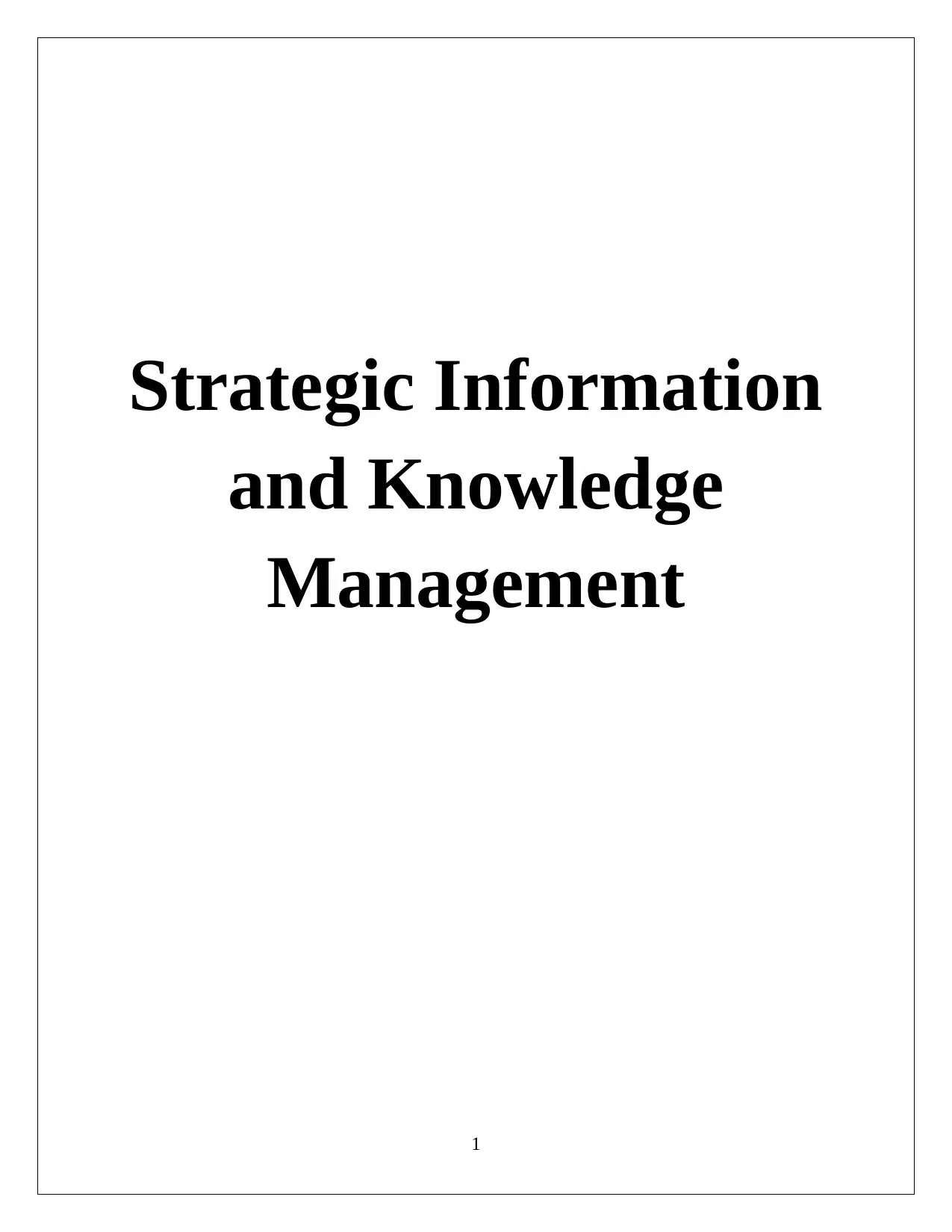
Strategic Information
and Knowledge
Management
1
and Knowledge
Management
1
Secure Best Marks with AI Grader
Need help grading? Try our AI Grader for instant feedback on your assignments.
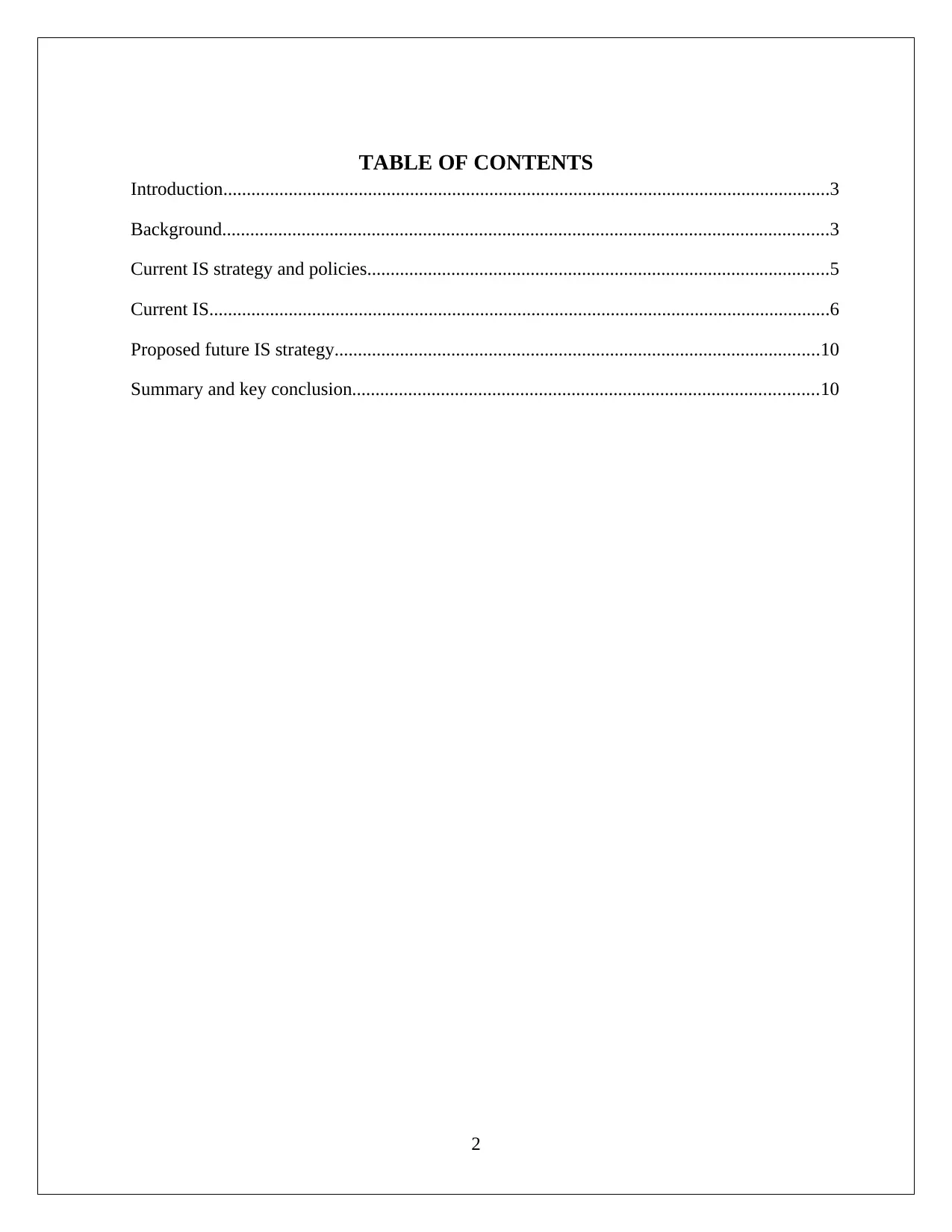
TABLE OF CONTENTS
Introduction..................................................................................................................................3
Background..................................................................................................................................3
Current IS strategy and policies...................................................................................................5
Current IS.....................................................................................................................................6
Proposed future IS strategy........................................................................................................10
Summary and key conclusion....................................................................................................10
2
Introduction..................................................................................................................................3
Background..................................................................................................................................3
Current IS strategy and policies...................................................................................................5
Current IS.....................................................................................................................................6
Proposed future IS strategy........................................................................................................10
Summary and key conclusion....................................................................................................10
2
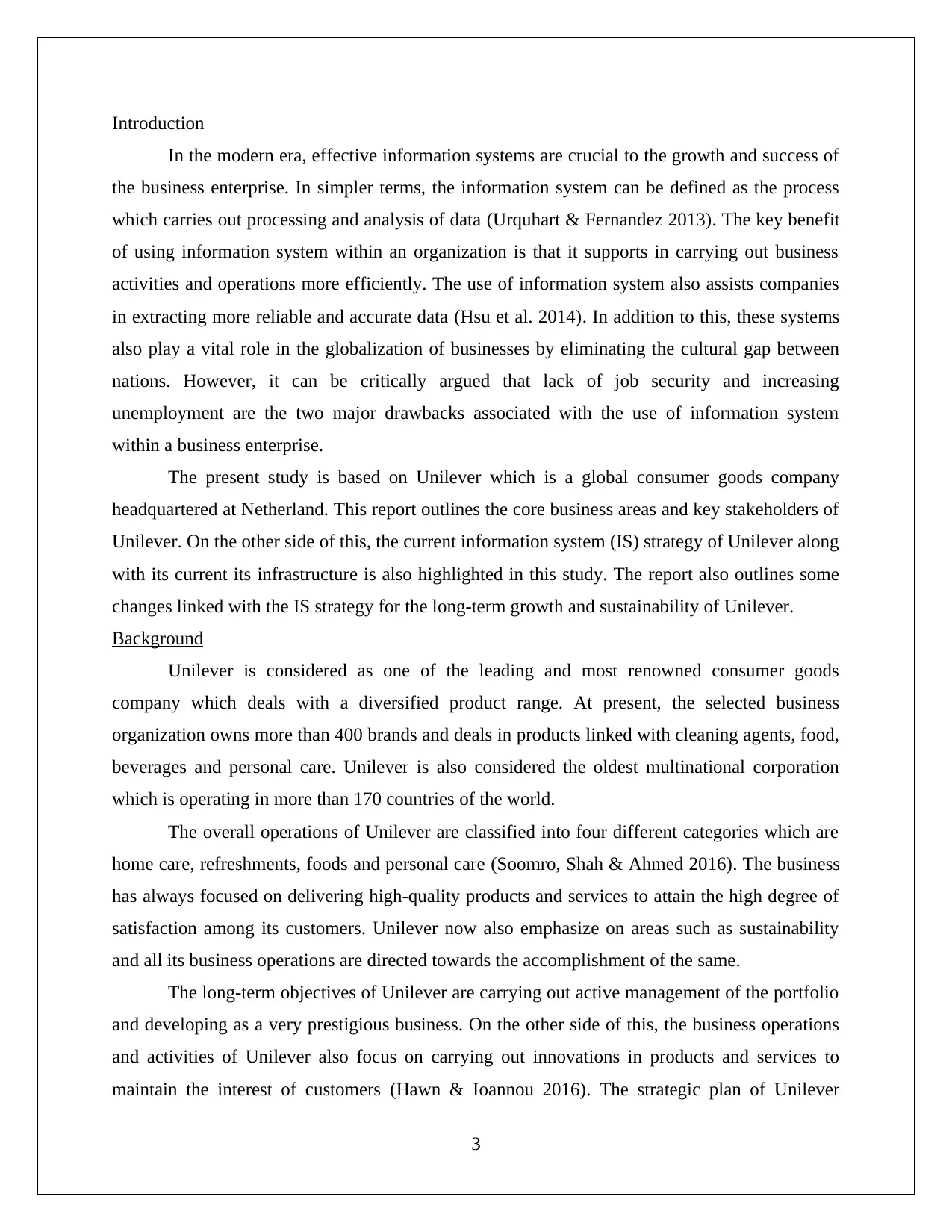
Introduction
In the modern era, effective information systems are crucial to the growth and success of
the business enterprise. In simpler terms, the information system can be defined as the process
which carries out processing and analysis of data (Urquhart & Fernandez 2013). The key benefit
of using information system within an organization is that it supports in carrying out business
activities and operations more efficiently. The use of information system also assists companies
in extracting more reliable and accurate data (Hsu et al. 2014). In addition to this, these systems
also play a vital role in the globalization of businesses by eliminating the cultural gap between
nations. However, it can be critically argued that lack of job security and increasing
unemployment are the two major drawbacks associated with the use of information system
within a business enterprise.
The present study is based on Unilever which is a global consumer goods company
headquartered at Netherland. This report outlines the core business areas and key stakeholders of
Unilever. On the other side of this, the current information system (IS) strategy of Unilever along
with its current its infrastructure is also highlighted in this study. The report also outlines some
changes linked with the IS strategy for the long-term growth and sustainability of Unilever.
Background
Unilever is considered as one of the leading and most renowned consumer goods
company which deals with a diversified product range. At present, the selected business
organization owns more than 400 brands and deals in products linked with cleaning agents, food,
beverages and personal care. Unilever is also considered the oldest multinational corporation
which is operating in more than 170 countries of the world.
The overall operations of Unilever are classified into four different categories which are
home care, refreshments, foods and personal care (Soomro, Shah & Ahmed 2016). The business
has always focused on delivering high-quality products and services to attain the high degree of
satisfaction among its customers. Unilever now also emphasize on areas such as sustainability
and all its business operations are directed towards the accomplishment of the same.
The long-term objectives of Unilever are carrying out active management of the portfolio
and developing as a very prestigious business. On the other side of this, the business operations
and activities of Unilever also focus on carrying out innovations in products and services to
maintain the interest of customers (Hawn & Ioannou 2016). The strategic plan of Unilever
3
In the modern era, effective information systems are crucial to the growth and success of
the business enterprise. In simpler terms, the information system can be defined as the process
which carries out processing and analysis of data (Urquhart & Fernandez 2013). The key benefit
of using information system within an organization is that it supports in carrying out business
activities and operations more efficiently. The use of information system also assists companies
in extracting more reliable and accurate data (Hsu et al. 2014). In addition to this, these systems
also play a vital role in the globalization of businesses by eliminating the cultural gap between
nations. However, it can be critically argued that lack of job security and increasing
unemployment are the two major drawbacks associated with the use of information system
within a business enterprise.
The present study is based on Unilever which is a global consumer goods company
headquartered at Netherland. This report outlines the core business areas and key stakeholders of
Unilever. On the other side of this, the current information system (IS) strategy of Unilever along
with its current its infrastructure is also highlighted in this study. The report also outlines some
changes linked with the IS strategy for the long-term growth and sustainability of Unilever.
Background
Unilever is considered as one of the leading and most renowned consumer goods
company which deals with a diversified product range. At present, the selected business
organization owns more than 400 brands and deals in products linked with cleaning agents, food,
beverages and personal care. Unilever is also considered the oldest multinational corporation
which is operating in more than 170 countries of the world.
The overall operations of Unilever are classified into four different categories which are
home care, refreshments, foods and personal care (Soomro, Shah & Ahmed 2016). The business
has always focused on delivering high-quality products and services to attain the high degree of
satisfaction among its customers. Unilever now also emphasize on areas such as sustainability
and all its business operations are directed towards the accomplishment of the same.
The long-term objectives of Unilever are carrying out active management of the portfolio
and developing as a very prestigious business. On the other side of this, the business operations
and activities of Unilever also focus on carrying out innovations in products and services to
maintain the interest of customers (Hawn & Ioannou 2016). The strategic plan of Unilever
3
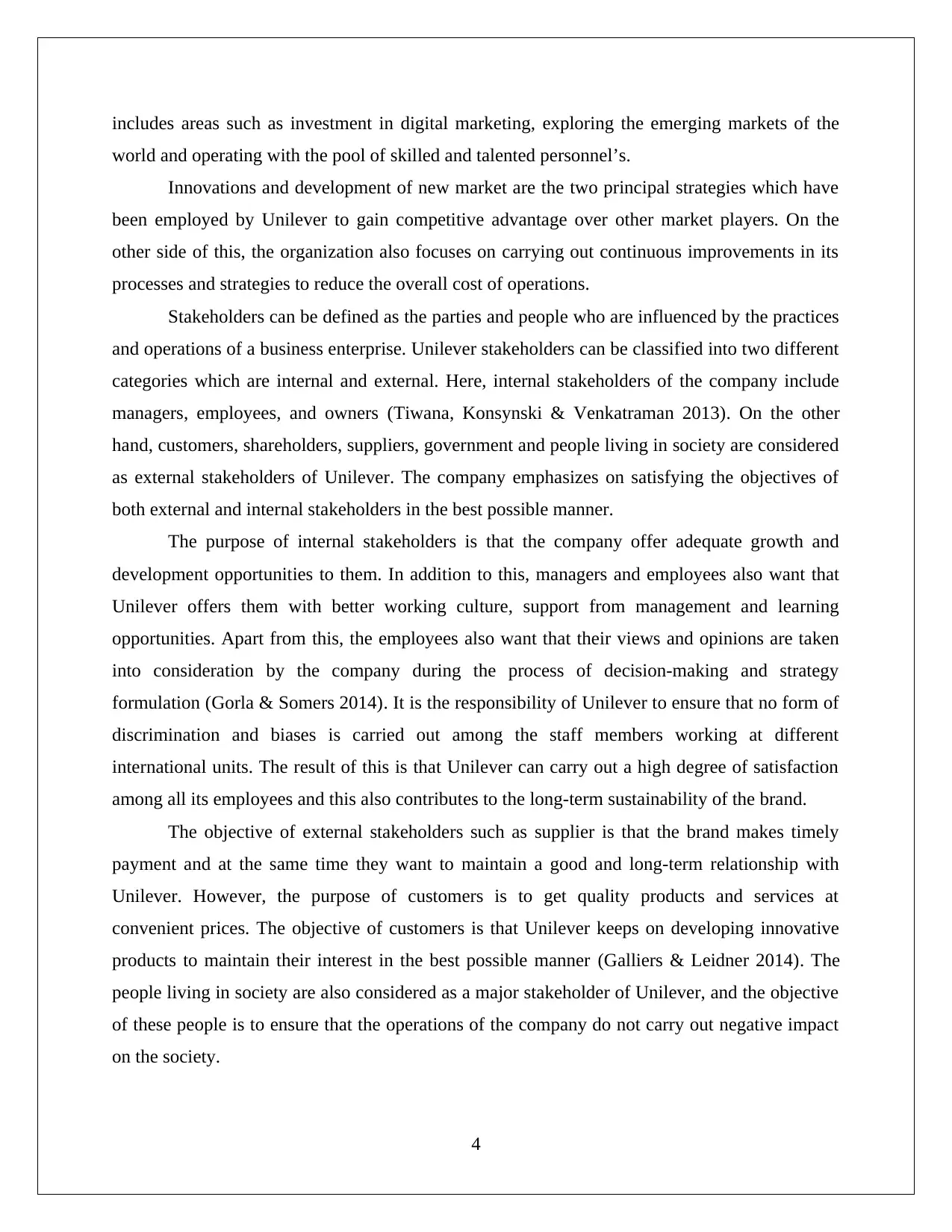
includes areas such as investment in digital marketing, exploring the emerging markets of the
world and operating with the pool of skilled and talented personnel’s.
Innovations and development of new market are the two principal strategies which have
been employed by Unilever to gain competitive advantage over other market players. On the
other side of this, the organization also focuses on carrying out continuous improvements in its
processes and strategies to reduce the overall cost of operations.
Stakeholders can be defined as the parties and people who are influenced by the practices
and operations of a business enterprise. Unilever stakeholders can be classified into two different
categories which are internal and external. Here, internal stakeholders of the company include
managers, employees, and owners (Tiwana, Konsynski & Venkatraman 2013). On the other
hand, customers, shareholders, suppliers, government and people living in society are considered
as external stakeholders of Unilever. The company emphasizes on satisfying the objectives of
both external and internal stakeholders in the best possible manner.
The purpose of internal stakeholders is that the company offer adequate growth and
development opportunities to them. In addition to this, managers and employees also want that
Unilever offers them with better working culture, support from management and learning
opportunities. Apart from this, the employees also want that their views and opinions are taken
into consideration by the company during the process of decision-making and strategy
formulation (Gorla & Somers 2014). It is the responsibility of Unilever to ensure that no form of
discrimination and biases is carried out among the staff members working at different
international units. The result of this is that Unilever can carry out a high degree of satisfaction
among all its employees and this also contributes to the long-term sustainability of the brand.
The objective of external stakeholders such as supplier is that the brand makes timely
payment and at the same time they want to maintain a good and long-term relationship with
Unilever. However, the purpose of customers is to get quality products and services at
convenient prices. The objective of customers is that Unilever keeps on developing innovative
products to maintain their interest in the best possible manner (Galliers & Leidner 2014). The
people living in society are also considered as a major stakeholder of Unilever, and the objective
of these people is to ensure that the operations of the company do not carry out negative impact
on the society.
4
world and operating with the pool of skilled and talented personnel’s.
Innovations and development of new market are the two principal strategies which have
been employed by Unilever to gain competitive advantage over other market players. On the
other side of this, the organization also focuses on carrying out continuous improvements in its
processes and strategies to reduce the overall cost of operations.
Stakeholders can be defined as the parties and people who are influenced by the practices
and operations of a business enterprise. Unilever stakeholders can be classified into two different
categories which are internal and external. Here, internal stakeholders of the company include
managers, employees, and owners (Tiwana, Konsynski & Venkatraman 2013). On the other
hand, customers, shareholders, suppliers, government and people living in society are considered
as external stakeholders of Unilever. The company emphasizes on satisfying the objectives of
both external and internal stakeholders in the best possible manner.
The purpose of internal stakeholders is that the company offer adequate growth and
development opportunities to them. In addition to this, managers and employees also want that
Unilever offers them with better working culture, support from management and learning
opportunities. Apart from this, the employees also want that their views and opinions are taken
into consideration by the company during the process of decision-making and strategy
formulation (Gorla & Somers 2014). It is the responsibility of Unilever to ensure that no form of
discrimination and biases is carried out among the staff members working at different
international units. The result of this is that Unilever can carry out a high degree of satisfaction
among all its employees and this also contributes to the long-term sustainability of the brand.
The objective of external stakeholders such as supplier is that the brand makes timely
payment and at the same time they want to maintain a good and long-term relationship with
Unilever. However, the purpose of customers is to get quality products and services at
convenient prices. The objective of customers is that Unilever keeps on developing innovative
products to maintain their interest in the best possible manner (Galliers & Leidner 2014). The
people living in society are also considered as a major stakeholder of Unilever, and the objective
of these people is to ensure that the operations of the company do not carry out negative impact
on the society.
4
Secure Best Marks with AI Grader
Need help grading? Try our AI Grader for instant feedback on your assignments.
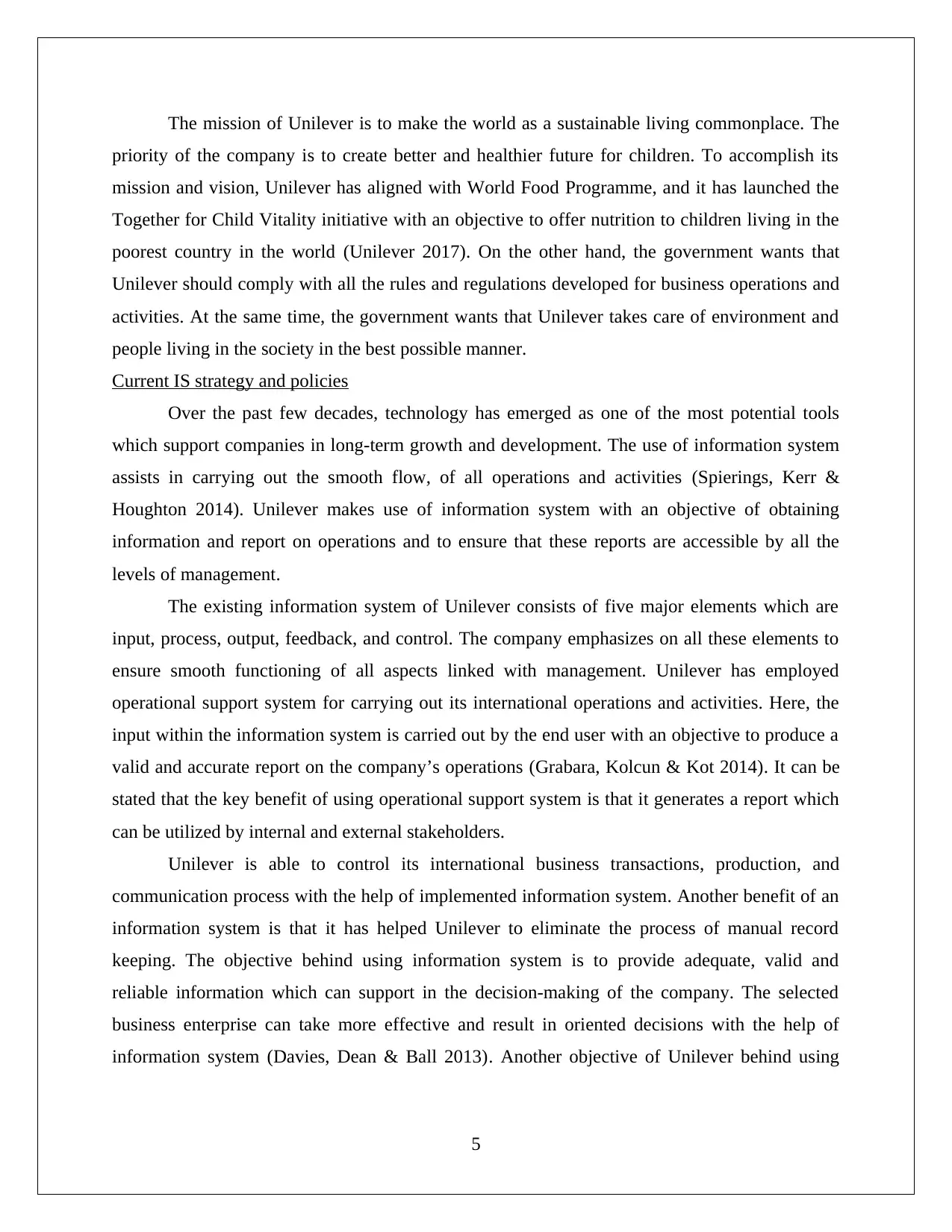
The mission of Unilever is to make the world as a sustainable living commonplace. The
priority of the company is to create better and healthier future for children. To accomplish its
mission and vision, Unilever has aligned with World Food Programme, and it has launched the
Together for Child Vitality initiative with an objective to offer nutrition to children living in the
poorest country in the world (Unilever 2017). On the other hand, the government wants that
Unilever should comply with all the rules and regulations developed for business operations and
activities. At the same time, the government wants that Unilever takes care of environment and
people living in the society in the best possible manner.
Current IS strategy and policies
Over the past few decades, technology has emerged as one of the most potential tools
which support companies in long-term growth and development. The use of information system
assists in carrying out the smooth flow, of all operations and activities (Spierings, Kerr &
Houghton 2014). Unilever makes use of information system with an objective of obtaining
information and report on operations and to ensure that these reports are accessible by all the
levels of management.
The existing information system of Unilever consists of five major elements which are
input, process, output, feedback, and control. The company emphasizes on all these elements to
ensure smooth functioning of all aspects linked with management. Unilever has employed
operational support system for carrying out its international operations and activities. Here, the
input within the information system is carried out by the end user with an objective to produce a
valid and accurate report on the company’s operations (Grabara, Kolcun & Kot 2014). It can be
stated that the key benefit of using operational support system is that it generates a report which
can be utilized by internal and external stakeholders.
Unilever is able to control its international business transactions, production, and
communication process with the help of implemented information system. Another benefit of an
information system is that it has helped Unilever to eliminate the process of manual record
keeping. The objective behind using information system is to provide adequate, valid and
reliable information which can support in the decision-making of the company. The selected
business enterprise can take more effective and result in oriented decisions with the help of
information system (Davies, Dean & Ball 2013). Another objective of Unilever behind using
5
priority of the company is to create better and healthier future for children. To accomplish its
mission and vision, Unilever has aligned with World Food Programme, and it has launched the
Together for Child Vitality initiative with an objective to offer nutrition to children living in the
poorest country in the world (Unilever 2017). On the other hand, the government wants that
Unilever should comply with all the rules and regulations developed for business operations and
activities. At the same time, the government wants that Unilever takes care of environment and
people living in the society in the best possible manner.
Current IS strategy and policies
Over the past few decades, technology has emerged as one of the most potential tools
which support companies in long-term growth and development. The use of information system
assists in carrying out the smooth flow, of all operations and activities (Spierings, Kerr &
Houghton 2014). Unilever makes use of information system with an objective of obtaining
information and report on operations and to ensure that these reports are accessible by all the
levels of management.
The existing information system of Unilever consists of five major elements which are
input, process, output, feedback, and control. The company emphasizes on all these elements to
ensure smooth functioning of all aspects linked with management. Unilever has employed
operational support system for carrying out its international operations and activities. Here, the
input within the information system is carried out by the end user with an objective to produce a
valid and accurate report on the company’s operations (Grabara, Kolcun & Kot 2014). It can be
stated that the key benefit of using operational support system is that it generates a report which
can be utilized by internal and external stakeholders.
Unilever is able to control its international business transactions, production, and
communication process with the help of implemented information system. Another benefit of an
information system is that it has helped Unilever to eliminate the process of manual record
keeping. The objective behind using information system is to provide adequate, valid and
reliable information which can support in the decision-making of the company. The selected
business enterprise can take more effective and result in oriented decisions with the help of
information system (Davies, Dean & Ball 2013). Another objective of Unilever behind using
5
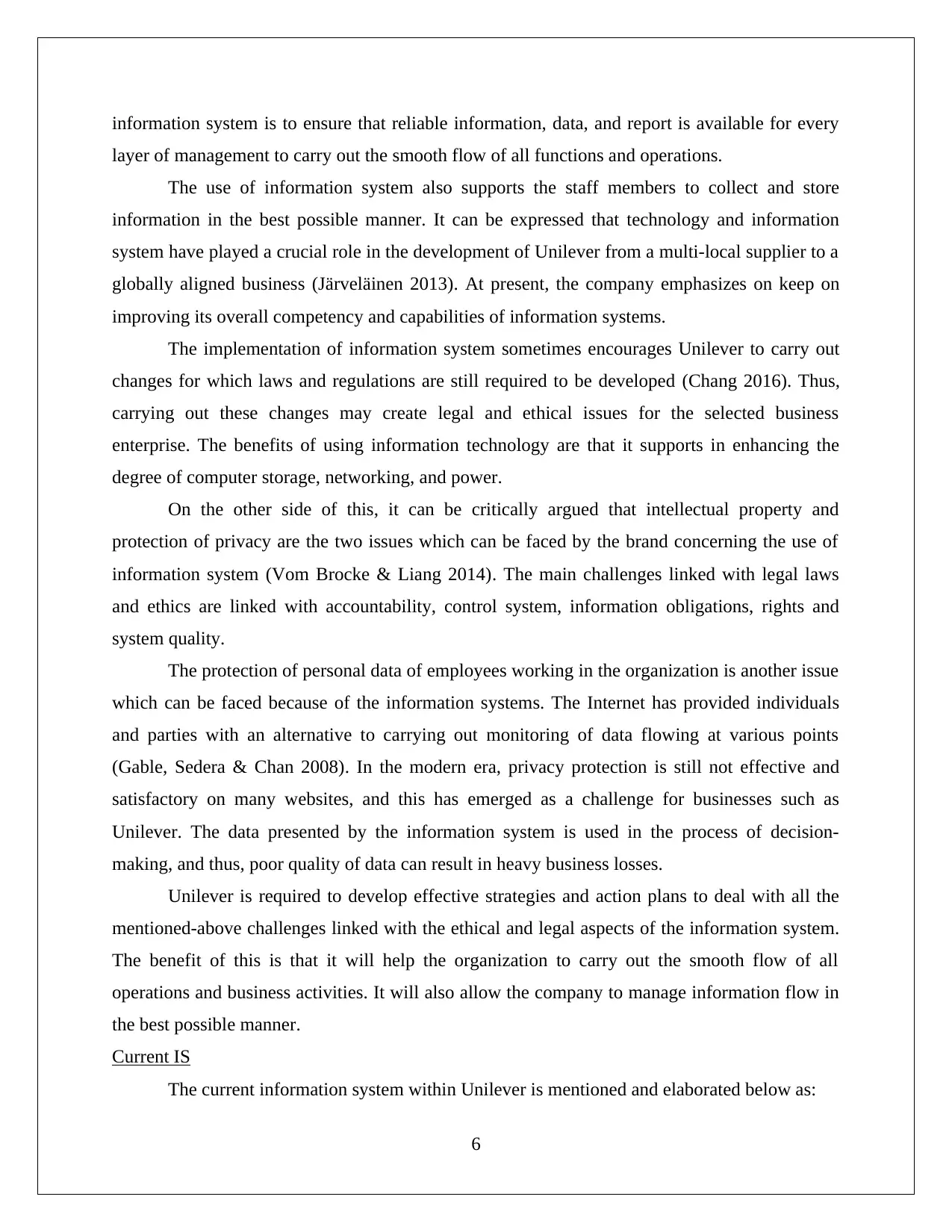
information system is to ensure that reliable information, data, and report is available for every
layer of management to carry out the smooth flow of all functions and operations.
The use of information system also supports the staff members to collect and store
information in the best possible manner. It can be expressed that technology and information
system have played a crucial role in the development of Unilever from a multi-local supplier to a
globally aligned business (Järveläinen 2013). At present, the company emphasizes on keep on
improving its overall competency and capabilities of information systems.
The implementation of information system sometimes encourages Unilever to carry out
changes for which laws and regulations are still required to be developed (Chang 2016). Thus,
carrying out these changes may create legal and ethical issues for the selected business
enterprise. The benefits of using information technology are that it supports in enhancing the
degree of computer storage, networking, and power.
On the other side of this, it can be critically argued that intellectual property and
protection of privacy are the two issues which can be faced by the brand concerning the use of
information system (Vom Brocke & Liang 2014). The main challenges linked with legal laws
and ethics are linked with accountability, control system, information obligations, rights and
system quality.
The protection of personal data of employees working in the organization is another issue
which can be faced because of the information systems. The Internet has provided individuals
and parties with an alternative to carrying out monitoring of data flowing at various points
(Gable, Sedera & Chan 2008). In the modern era, privacy protection is still not effective and
satisfactory on many websites, and this has emerged as a challenge for businesses such as
Unilever. The data presented by the information system is used in the process of decision-
making, and thus, poor quality of data can result in heavy business losses.
Unilever is required to develop effective strategies and action plans to deal with all the
mentioned-above challenges linked with the ethical and legal aspects of the information system.
The benefit of this is that it will help the organization to carry out the smooth flow of all
operations and business activities. It will also allow the company to manage information flow in
the best possible manner.
Current IS
The current information system within Unilever is mentioned and elaborated below as:
6
layer of management to carry out the smooth flow of all functions and operations.
The use of information system also supports the staff members to collect and store
information in the best possible manner. It can be expressed that technology and information
system have played a crucial role in the development of Unilever from a multi-local supplier to a
globally aligned business (Järveläinen 2013). At present, the company emphasizes on keep on
improving its overall competency and capabilities of information systems.
The implementation of information system sometimes encourages Unilever to carry out
changes for which laws and regulations are still required to be developed (Chang 2016). Thus,
carrying out these changes may create legal and ethical issues for the selected business
enterprise. The benefits of using information technology are that it supports in enhancing the
degree of computer storage, networking, and power.
On the other side of this, it can be critically argued that intellectual property and
protection of privacy are the two issues which can be faced by the brand concerning the use of
information system (Vom Brocke & Liang 2014). The main challenges linked with legal laws
and ethics are linked with accountability, control system, information obligations, rights and
system quality.
The protection of personal data of employees working in the organization is another issue
which can be faced because of the information systems. The Internet has provided individuals
and parties with an alternative to carrying out monitoring of data flowing at various points
(Gable, Sedera & Chan 2008). In the modern era, privacy protection is still not effective and
satisfactory on many websites, and this has emerged as a challenge for businesses such as
Unilever. The data presented by the information system is used in the process of decision-
making, and thus, poor quality of data can result in heavy business losses.
Unilever is required to develop effective strategies and action plans to deal with all the
mentioned-above challenges linked with the ethical and legal aspects of the information system.
The benefit of this is that it will help the organization to carry out the smooth flow of all
operations and business activities. It will also allow the company to manage information flow in
the best possible manner.
Current IS
The current information system within Unilever is mentioned and elaborated below as:
6
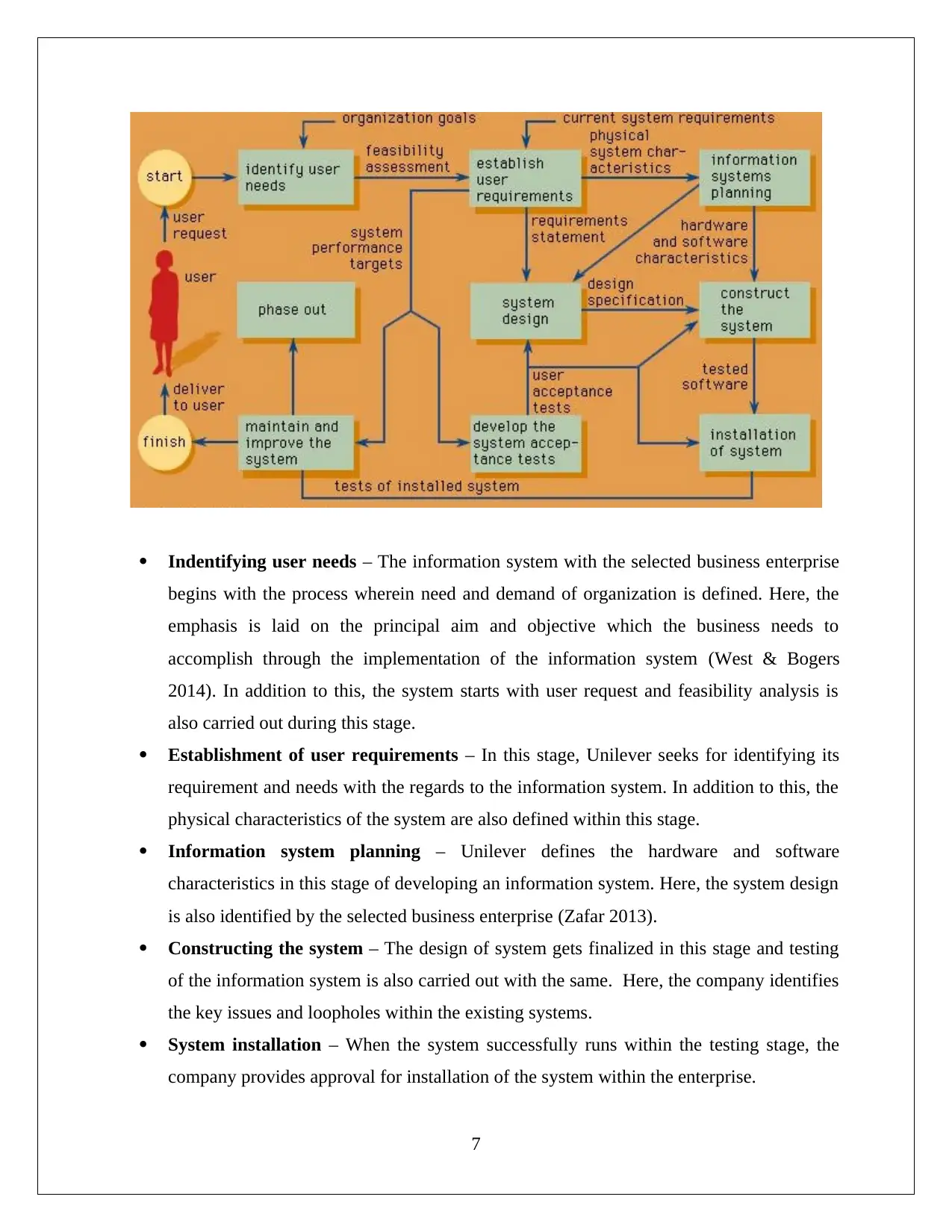
Indentifying user needs – The information system with the selected business enterprise
begins with the process wherein need and demand of organization is defined. Here, the
emphasis is laid on the principal aim and objective which the business needs to
accomplish through the implementation of the information system (West & Bogers
2014). In addition to this, the system starts with user request and feasibility analysis is
also carried out during this stage.
Establishment of user requirements – In this stage, Unilever seeks for identifying its
requirement and needs with the regards to the information system. In addition to this, the
physical characteristics of the system are also defined within this stage.
Information system planning – Unilever defines the hardware and software
characteristics in this stage of developing an information system. Here, the system design
is also identified by the selected business enterprise (Zafar 2013).
Constructing the system – The design of system gets finalized in this stage and testing
of the information system is also carried out with the same. Here, the company identifies
the key issues and loopholes within the existing systems.
System installation – When the system successfully runs within the testing stage, the
company provides approval for installation of the system within the enterprise.
7
begins with the process wherein need and demand of organization is defined. Here, the
emphasis is laid on the principal aim and objective which the business needs to
accomplish through the implementation of the information system (West & Bogers
2014). In addition to this, the system starts with user request and feasibility analysis is
also carried out during this stage.
Establishment of user requirements – In this stage, Unilever seeks for identifying its
requirement and needs with the regards to the information system. In addition to this, the
physical characteristics of the system are also defined within this stage.
Information system planning – Unilever defines the hardware and software
characteristics in this stage of developing an information system. Here, the system design
is also identified by the selected business enterprise (Zafar 2013).
Constructing the system – The design of system gets finalized in this stage and testing
of the information system is also carried out with the same. Here, the company identifies
the key issues and loopholes within the existing systems.
System installation – When the system successfully runs within the testing stage, the
company provides approval for installation of the system within the enterprise.
7
Paraphrase This Document
Need a fresh take? Get an instant paraphrase of this document with our AI Paraphraser
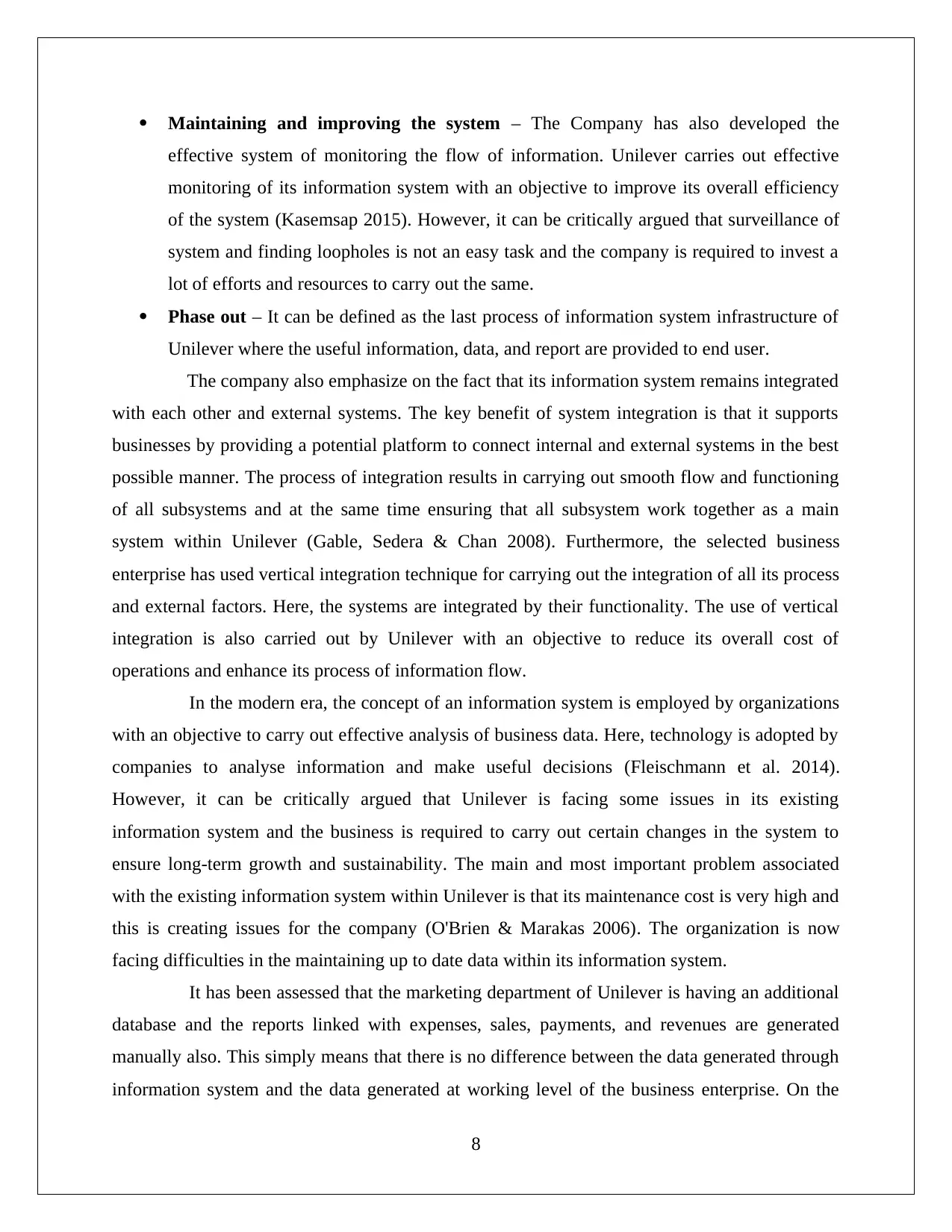
Maintaining and improving the system – The Company has also developed the
effective system of monitoring the flow of information. Unilever carries out effective
monitoring of its information system with an objective to improve its overall efficiency
of the system (Kasemsap 2015). However, it can be critically argued that surveillance of
system and finding loopholes is not an easy task and the company is required to invest a
lot of efforts and resources to carry out the same.
Phase out – It can be defined as the last process of information system infrastructure of
Unilever where the useful information, data, and report are provided to end user.
The company also emphasize on the fact that its information system remains integrated
with each other and external systems. The key benefit of system integration is that it supports
businesses by providing a potential platform to connect internal and external systems in the best
possible manner. The process of integration results in carrying out smooth flow and functioning
of all subsystems and at the same time ensuring that all subsystem work together as a main
system within Unilever (Gable, Sedera & Chan 2008). Furthermore, the selected business
enterprise has used vertical integration technique for carrying out the integration of all its process
and external factors. Here, the systems are integrated by their functionality. The use of vertical
integration is also carried out by Unilever with an objective to reduce its overall cost of
operations and enhance its process of information flow.
In the modern era, the concept of an information system is employed by organizations
with an objective to carry out effective analysis of business data. Here, technology is adopted by
companies to analyse information and make useful decisions (Fleischmann et al. 2014).
However, it can be critically argued that Unilever is facing some issues in its existing
information system and the business is required to carry out certain changes in the system to
ensure long-term growth and sustainability. The main and most important problem associated
with the existing information system within Unilever is that its maintenance cost is very high and
this is creating issues for the company (O'Brien & Marakas 2006). The organization is now
facing difficulties in the maintaining up to date data within its information system.
It has been assessed that the marketing department of Unilever is having an additional
database and the reports linked with expenses, sales, payments, and revenues are generated
manually also. This simply means that there is no difference between the data generated through
information system and the data generated at working level of the business enterprise. On the
8
effective system of monitoring the flow of information. Unilever carries out effective
monitoring of its information system with an objective to improve its overall efficiency
of the system (Kasemsap 2015). However, it can be critically argued that surveillance of
system and finding loopholes is not an easy task and the company is required to invest a
lot of efforts and resources to carry out the same.
Phase out – It can be defined as the last process of information system infrastructure of
Unilever where the useful information, data, and report are provided to end user.
The company also emphasize on the fact that its information system remains integrated
with each other and external systems. The key benefit of system integration is that it supports
businesses by providing a potential platform to connect internal and external systems in the best
possible manner. The process of integration results in carrying out smooth flow and functioning
of all subsystems and at the same time ensuring that all subsystem work together as a main
system within Unilever (Gable, Sedera & Chan 2008). Furthermore, the selected business
enterprise has used vertical integration technique for carrying out the integration of all its process
and external factors. Here, the systems are integrated by their functionality. The use of vertical
integration is also carried out by Unilever with an objective to reduce its overall cost of
operations and enhance its process of information flow.
In the modern era, the concept of an information system is employed by organizations
with an objective to carry out effective analysis of business data. Here, technology is adopted by
companies to analyse information and make useful decisions (Fleischmann et al. 2014).
However, it can be critically argued that Unilever is facing some issues in its existing
information system and the business is required to carry out certain changes in the system to
ensure long-term growth and sustainability. The main and most important problem associated
with the existing information system within Unilever is that its maintenance cost is very high and
this is creating issues for the company (O'Brien & Marakas 2006). The organization is now
facing difficulties in the maintaining up to date data within its information system.
It has been assessed that the marketing department of Unilever is having an additional
database and the reports linked with expenses, sales, payments, and revenues are generated
manually also. This simply means that there is no difference between the data generated through
information system and the data generated at working level of the business enterprise. On the
8
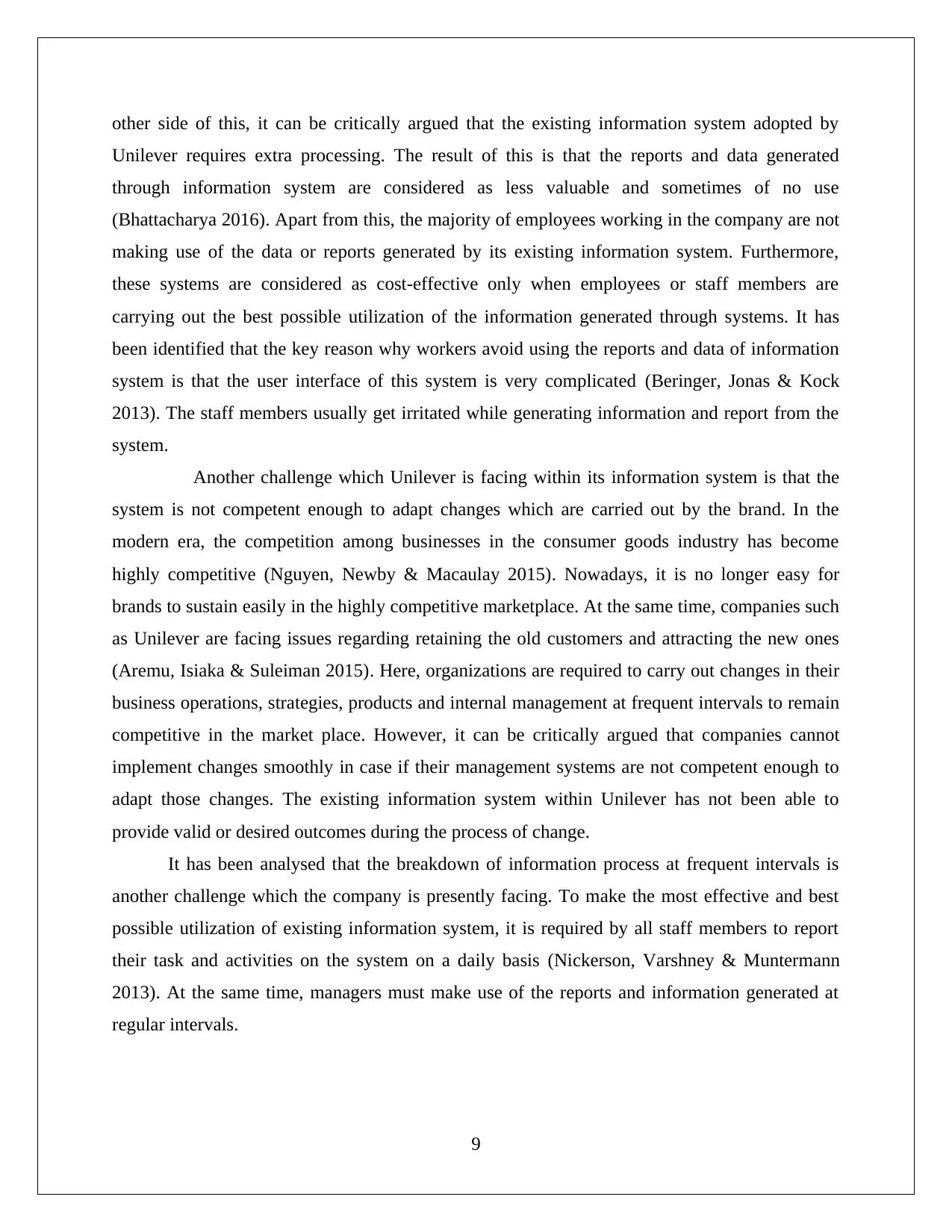
other side of this, it can be critically argued that the existing information system adopted by
Unilever requires extra processing. The result of this is that the reports and data generated
through information system are considered as less valuable and sometimes of no use
(Bhattacharya 2016). Apart from this, the majority of employees working in the company are not
making use of the data or reports generated by its existing information system. Furthermore,
these systems are considered as cost-effective only when employees or staff members are
carrying out the best possible utilization of the information generated through systems. It has
been identified that the key reason why workers avoid using the reports and data of information
system is that the user interface of this system is very complicated (Beringer, Jonas & Kock
2013). The staff members usually get irritated while generating information and report from the
system.
Another challenge which Unilever is facing within its information system is that the
system is not competent enough to adapt changes which are carried out by the brand. In the
modern era, the competition among businesses in the consumer goods industry has become
highly competitive (Nguyen, Newby & Macaulay 2015). Nowadays, it is no longer easy for
brands to sustain easily in the highly competitive marketplace. At the same time, companies such
as Unilever are facing issues regarding retaining the old customers and attracting the new ones
(Aremu, Isiaka & Suleiman 2015). Here, organizations are required to carry out changes in their
business operations, strategies, products and internal management at frequent intervals to remain
competitive in the market place. However, it can be critically argued that companies cannot
implement changes smoothly in case if their management systems are not competent enough to
adapt those changes. The existing information system within Unilever has not been able to
provide valid or desired outcomes during the process of change.
It has been analysed that the breakdown of information process at frequent intervals is
another challenge which the company is presently facing. To make the most effective and best
possible utilization of existing information system, it is required by all staff members to report
their task and activities on the system on a daily basis (Nickerson, Varshney & Muntermann
2013). At the same time, managers must make use of the reports and information generated at
regular intervals.
9
Unilever requires extra processing. The result of this is that the reports and data generated
through information system are considered as less valuable and sometimes of no use
(Bhattacharya 2016). Apart from this, the majority of employees working in the company are not
making use of the data or reports generated by its existing information system. Furthermore,
these systems are considered as cost-effective only when employees or staff members are
carrying out the best possible utilization of the information generated through systems. It has
been identified that the key reason why workers avoid using the reports and data of information
system is that the user interface of this system is very complicated (Beringer, Jonas & Kock
2013). The staff members usually get irritated while generating information and report from the
system.
Another challenge which Unilever is facing within its information system is that the
system is not competent enough to adapt changes which are carried out by the brand. In the
modern era, the competition among businesses in the consumer goods industry has become
highly competitive (Nguyen, Newby & Macaulay 2015). Nowadays, it is no longer easy for
brands to sustain easily in the highly competitive marketplace. At the same time, companies such
as Unilever are facing issues regarding retaining the old customers and attracting the new ones
(Aremu, Isiaka & Suleiman 2015). Here, organizations are required to carry out changes in their
business operations, strategies, products and internal management at frequent intervals to remain
competitive in the market place. However, it can be critically argued that companies cannot
implement changes smoothly in case if their management systems are not competent enough to
adapt those changes. The existing information system within Unilever has not been able to
provide valid or desired outcomes during the process of change.
It has been analysed that the breakdown of information process at frequent intervals is
another challenge which the company is presently facing. To make the most effective and best
possible utilization of existing information system, it is required by all staff members to report
their task and activities on the system on a daily basis (Nickerson, Varshney & Muntermann
2013). At the same time, managers must make use of the reports and information generated at
regular intervals.
9
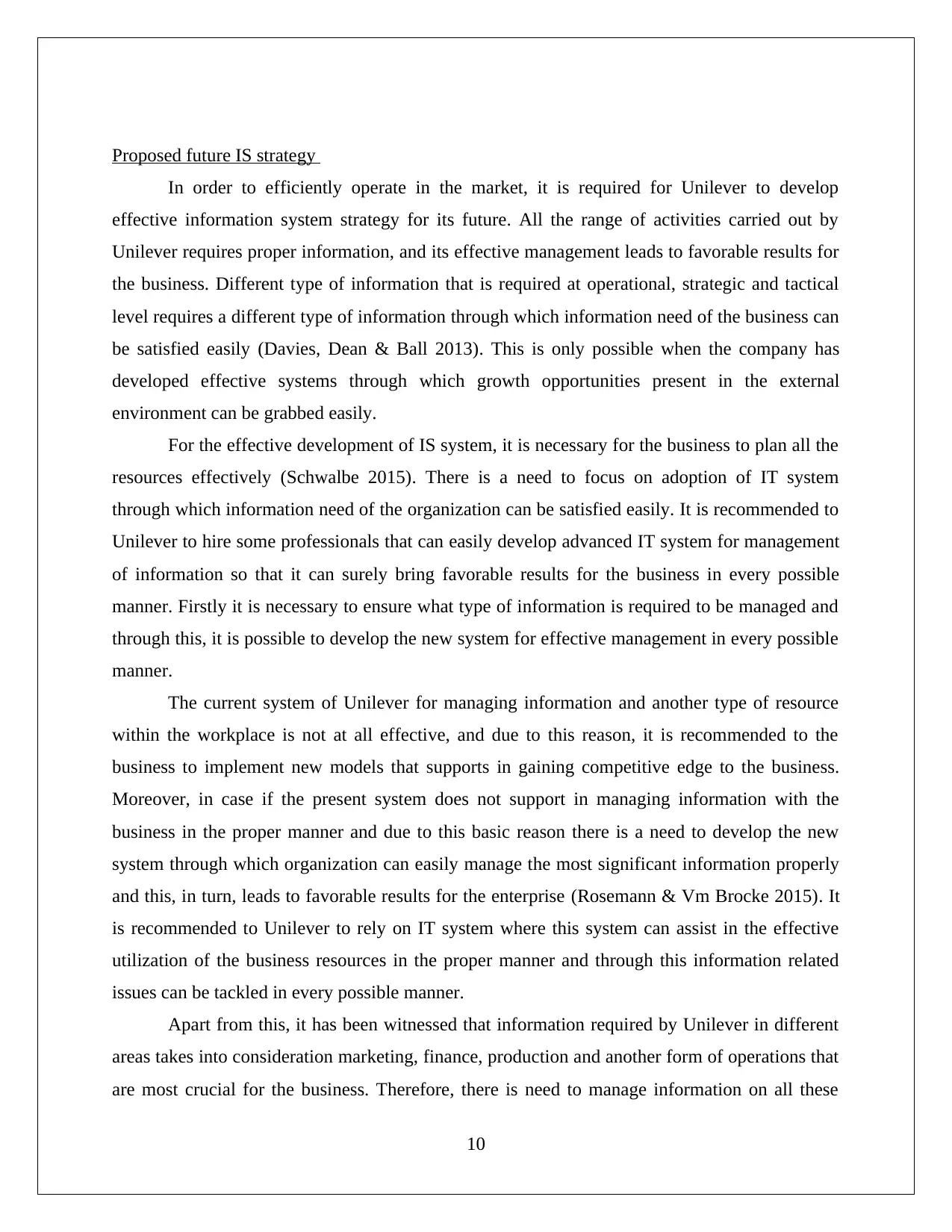
Proposed future IS strategy
In order to efficiently operate in the market, it is required for Unilever to develop
effective information system strategy for its future. All the range of activities carried out by
Unilever requires proper information, and its effective management leads to favorable results for
the business. Different type of information that is required at operational, strategic and tactical
level requires a different type of information through which information need of the business can
be satisfied easily (Davies, Dean & Ball 2013). This is only possible when the company has
developed effective systems through which growth opportunities present in the external
environment can be grabbed easily.
For the effective development of IS system, it is necessary for the business to plan all the
resources effectively (Schwalbe 2015). There is a need to focus on adoption of IT system
through which information need of the organization can be satisfied easily. It is recommended to
Unilever to hire some professionals that can easily develop advanced IT system for management
of information so that it can surely bring favorable results for the business in every possible
manner. Firstly it is necessary to ensure what type of information is required to be managed and
through this, it is possible to develop the new system for effective management in every possible
manner.
The current system of Unilever for managing information and another type of resource
within the workplace is not at all effective, and due to this reason, it is recommended to the
business to implement new models that supports in gaining competitive edge to the business.
Moreover, in case if the present system does not support in managing information with the
business in the proper manner and due to this basic reason there is a need to develop the new
system through which organization can easily manage the most significant information properly
and this, in turn, leads to favorable results for the enterprise (Rosemann & Vm Brocke 2015). It
is recommended to Unilever to rely on IT system where this system can assist in the effective
utilization of the business resources in the proper manner and through this information related
issues can be tackled in every possible manner.
Apart from this, it has been witnessed that information required by Unilever in different
areas takes into consideration marketing, finance, production and another form of operations that
are most crucial for the business. Therefore, there is need to manage information on all these
10
In order to efficiently operate in the market, it is required for Unilever to develop
effective information system strategy for its future. All the range of activities carried out by
Unilever requires proper information, and its effective management leads to favorable results for
the business. Different type of information that is required at operational, strategic and tactical
level requires a different type of information through which information need of the business can
be satisfied easily (Davies, Dean & Ball 2013). This is only possible when the company has
developed effective systems through which growth opportunities present in the external
environment can be grabbed easily.
For the effective development of IS system, it is necessary for the business to plan all the
resources effectively (Schwalbe 2015). There is a need to focus on adoption of IT system
through which information need of the organization can be satisfied easily. It is recommended to
Unilever to hire some professionals that can easily develop advanced IT system for management
of information so that it can surely bring favorable results for the business in every possible
manner. Firstly it is necessary to ensure what type of information is required to be managed and
through this, it is possible to develop the new system for effective management in every possible
manner.
The current system of Unilever for managing information and another type of resource
within the workplace is not at all effective, and due to this reason, it is recommended to the
business to implement new models that supports in gaining competitive edge to the business.
Moreover, in case if the present system does not support in managing information with the
business in the proper manner and due to this basic reason there is a need to develop the new
system through which organization can easily manage the most significant information properly
and this, in turn, leads to favorable results for the enterprise (Rosemann & Vm Brocke 2015). It
is recommended to Unilever to rely on IT system where this system can assist in the effective
utilization of the business resources in the proper manner and through this information related
issues can be tackled in every possible manner.
Apart from this, it has been witnessed that information required by Unilever in different
areas takes into consideration marketing, finance, production and another form of operations that
are most crucial for the business. Therefore, there is need to manage information on all these
10
Secure Best Marks with AI Grader
Need help grading? Try our AI Grader for instant feedback on your assignments.
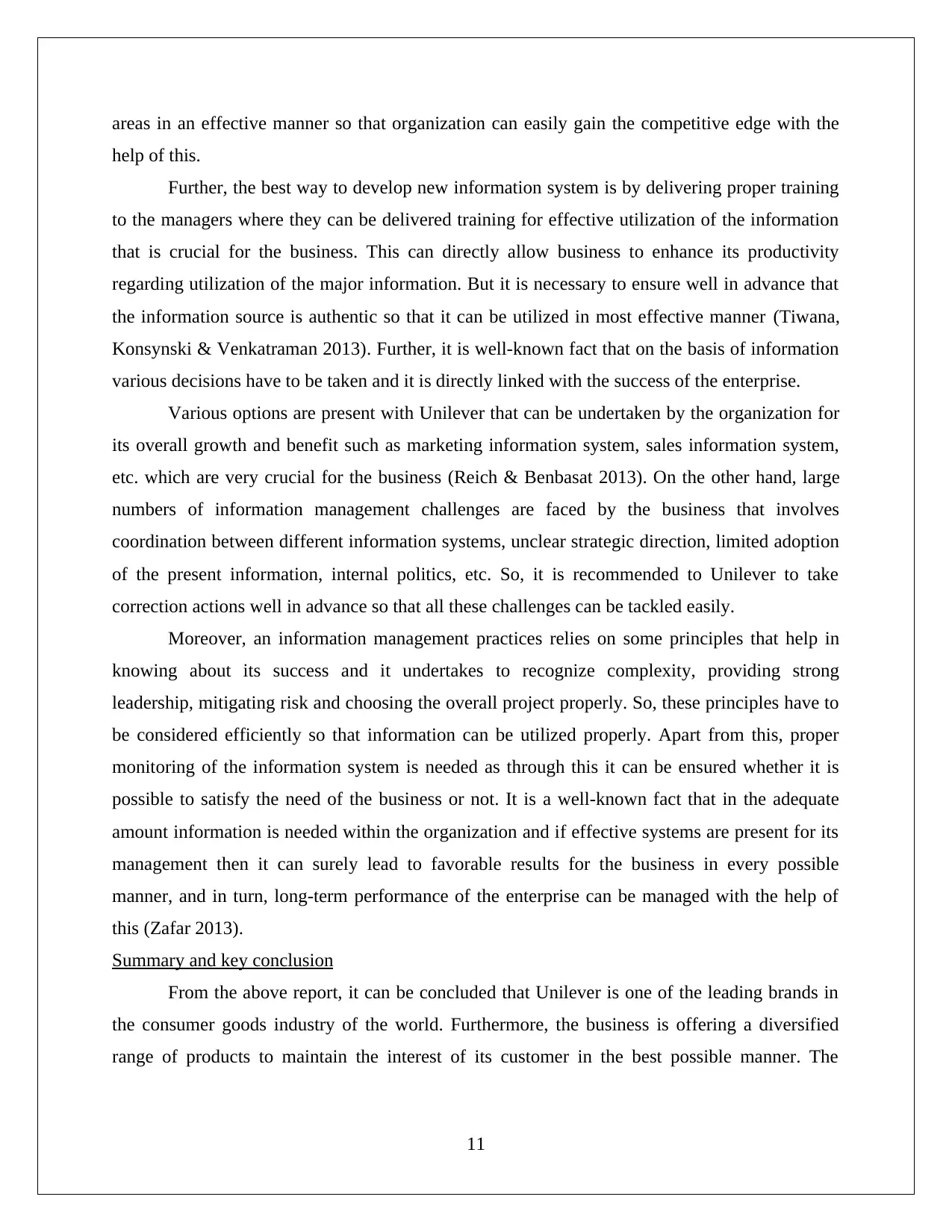
areas in an effective manner so that organization can easily gain the competitive edge with the
help of this.
Further, the best way to develop new information system is by delivering proper training
to the managers where they can be delivered training for effective utilization of the information
that is crucial for the business. This can directly allow business to enhance its productivity
regarding utilization of the major information. But it is necessary to ensure well in advance that
the information source is authentic so that it can be utilized in most effective manner (Tiwana,
Konsynski & Venkatraman 2013). Further, it is well-known fact that on the basis of information
various decisions have to be taken and it is directly linked with the success of the enterprise.
Various options are present with Unilever that can be undertaken by the organization for
its overall growth and benefit such as marketing information system, sales information system,
etc. which are very crucial for the business (Reich & Benbasat 2013). On the other hand, large
numbers of information management challenges are faced by the business that involves
coordination between different information systems, unclear strategic direction, limited adoption
of the present information, internal politics, etc. So, it is recommended to Unilever to take
correction actions well in advance so that all these challenges can be tackled easily.
Moreover, an information management practices relies on some principles that help in
knowing about its success and it undertakes to recognize complexity, providing strong
leadership, mitigating risk and choosing the overall project properly. So, these principles have to
be considered efficiently so that information can be utilized properly. Apart from this, proper
monitoring of the information system is needed as through this it can be ensured whether it is
possible to satisfy the need of the business or not. It is a well-known fact that in the adequate
amount information is needed within the organization and if effective systems are present for its
management then it can surely lead to favorable results for the business in every possible
manner, and in turn, long-term performance of the enterprise can be managed with the help of
this (Zafar 2013).
Summary and key conclusion
From the above report, it can be concluded that Unilever is one of the leading brands in
the consumer goods industry of the world. Furthermore, the business is offering a diversified
range of products to maintain the interest of its customer in the best possible manner. The
11
help of this.
Further, the best way to develop new information system is by delivering proper training
to the managers where they can be delivered training for effective utilization of the information
that is crucial for the business. This can directly allow business to enhance its productivity
regarding utilization of the major information. But it is necessary to ensure well in advance that
the information source is authentic so that it can be utilized in most effective manner (Tiwana,
Konsynski & Venkatraman 2013). Further, it is well-known fact that on the basis of information
various decisions have to be taken and it is directly linked with the success of the enterprise.
Various options are present with Unilever that can be undertaken by the organization for
its overall growth and benefit such as marketing information system, sales information system,
etc. which are very crucial for the business (Reich & Benbasat 2013). On the other hand, large
numbers of information management challenges are faced by the business that involves
coordination between different information systems, unclear strategic direction, limited adoption
of the present information, internal politics, etc. So, it is recommended to Unilever to take
correction actions well in advance so that all these challenges can be tackled easily.
Moreover, an information management practices relies on some principles that help in
knowing about its success and it undertakes to recognize complexity, providing strong
leadership, mitigating risk and choosing the overall project properly. So, these principles have to
be considered efficiently so that information can be utilized properly. Apart from this, proper
monitoring of the information system is needed as through this it can be ensured whether it is
possible to satisfy the need of the business or not. It is a well-known fact that in the adequate
amount information is needed within the organization and if effective systems are present for its
management then it can surely lead to favorable results for the business in every possible
manner, and in turn, long-term performance of the enterprise can be managed with the help of
this (Zafar 2013).
Summary and key conclusion
From the above report, it can be concluded that Unilever is one of the leading brands in
the consumer goods industry of the world. Furthermore, the business is offering a diversified
range of products to maintain the interest of its customer in the best possible manner. The
11
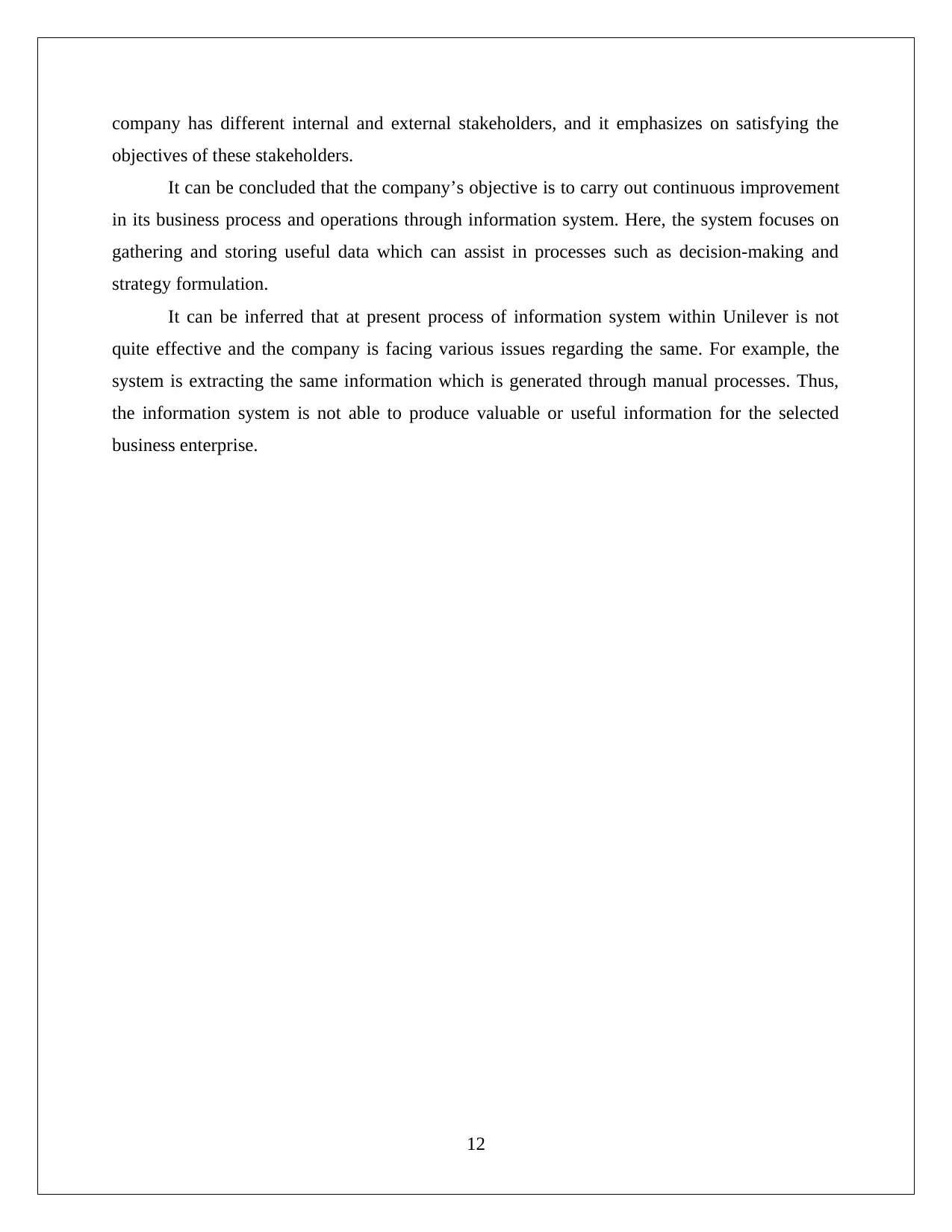
company has different internal and external stakeholders, and it emphasizes on satisfying the
objectives of these stakeholders.
It can be concluded that the company’s objective is to carry out continuous improvement
in its business process and operations through information system. Here, the system focuses on
gathering and storing useful data which can assist in processes such as decision-making and
strategy formulation.
It can be inferred that at present process of information system within Unilever is not
quite effective and the company is facing various issues regarding the same. For example, the
system is extracting the same information which is generated through manual processes. Thus,
the information system is not able to produce valuable or useful information for the selected
business enterprise.
12
objectives of these stakeholders.
It can be concluded that the company’s objective is to carry out continuous improvement
in its business process and operations through information system. Here, the system focuses on
gathering and storing useful data which can assist in processes such as decision-making and
strategy formulation.
It can be inferred that at present process of information system within Unilever is not
quite effective and the company is facing various issues regarding the same. For example, the
system is extracting the same information which is generated through manual processes. Thus,
the information system is not able to produce valuable or useful information for the selected
business enterprise.
12
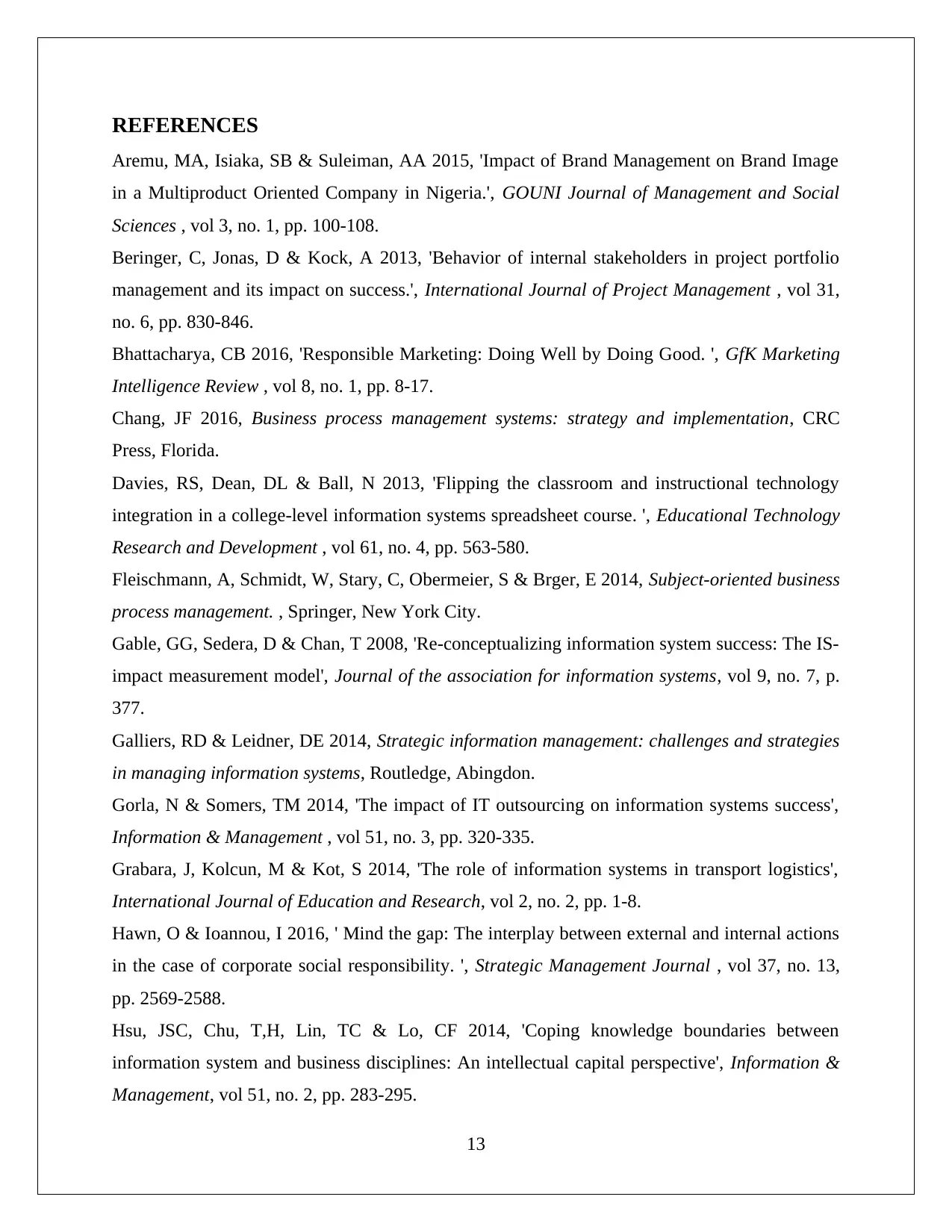
REFERENCES
Aremu, MA, Isiaka, SB & Suleiman, AA 2015, 'Impact of Brand Management on Brand Image
in a Multiproduct Oriented Company in Nigeria.', GOUNI Journal of Management and Social
Sciences , vol 3, no. 1, pp. 100-108.
Beringer, C, Jonas, D & Kock, A 2013, 'Behavior of internal stakeholders in project portfolio
management and its impact on success.', International Journal of Project Management , vol 31,
no. 6, pp. 830-846.
Bhattacharya, CB 2016, 'Responsible Marketing: Doing Well by Doing Good. ', GfK Marketing
Intelligence Review , vol 8, no. 1, pp. 8-17.
Chang, JF 2016, Business process management systems: strategy and implementation, CRC
Press, Florida.
Davies, RS, Dean, DL & Ball, N 2013, 'Flipping the classroom and instructional technology
integration in a college-level information systems spreadsheet course. ', Educational Technology
Research and Development , vol 61, no. 4, pp. 563-580.
Fleischmann, A, Schmidt, W, Stary, C, Obermeier, S & Brger, E 2014, Subject-oriented business
process management. , Springer, New York City.
Gable, GG, Sedera, D & Chan, T 2008, 'Re-conceptualizing information system success: The IS-
impact measurement model', Journal of the association for information systems, vol 9, no. 7, p.
377.
Galliers, RD & Leidner, DE 2014, Strategic information management: challenges and strategies
in managing information systems, Routledge, Abingdon.
Gorla, N & Somers, TM 2014, 'The impact of IT outsourcing on information systems success',
Information & Management , vol 51, no. 3, pp. 320-335.
Grabara, J, Kolcun, M & Kot, S 2014, 'The role of information systems in transport logistics',
International Journal of Education and Research, vol 2, no. 2, pp. 1-8.
Hawn, O & Ioannou, I 2016, ' Mind the gap: The interplay between external and internal actions
in the case of corporate social responsibility. ', Strategic Management Journal , vol 37, no. 13,
pp. 2569-2588.
Hsu, JSC, Chu, T,H, Lin, TC & Lo, CF 2014, 'Coping knowledge boundaries between
information system and business disciplines: An intellectual capital perspective', Information &
Management, vol 51, no. 2, pp. 283-295.
13
Aremu, MA, Isiaka, SB & Suleiman, AA 2015, 'Impact of Brand Management on Brand Image
in a Multiproduct Oriented Company in Nigeria.', GOUNI Journal of Management and Social
Sciences , vol 3, no. 1, pp. 100-108.
Beringer, C, Jonas, D & Kock, A 2013, 'Behavior of internal stakeholders in project portfolio
management and its impact on success.', International Journal of Project Management , vol 31,
no. 6, pp. 830-846.
Bhattacharya, CB 2016, 'Responsible Marketing: Doing Well by Doing Good. ', GfK Marketing
Intelligence Review , vol 8, no. 1, pp. 8-17.
Chang, JF 2016, Business process management systems: strategy and implementation, CRC
Press, Florida.
Davies, RS, Dean, DL & Ball, N 2013, 'Flipping the classroom and instructional technology
integration in a college-level information systems spreadsheet course. ', Educational Technology
Research and Development , vol 61, no. 4, pp. 563-580.
Fleischmann, A, Schmidt, W, Stary, C, Obermeier, S & Brger, E 2014, Subject-oriented business
process management. , Springer, New York City.
Gable, GG, Sedera, D & Chan, T 2008, 'Re-conceptualizing information system success: The IS-
impact measurement model', Journal of the association for information systems, vol 9, no. 7, p.
377.
Galliers, RD & Leidner, DE 2014, Strategic information management: challenges and strategies
in managing information systems, Routledge, Abingdon.
Gorla, N & Somers, TM 2014, 'The impact of IT outsourcing on information systems success',
Information & Management , vol 51, no. 3, pp. 320-335.
Grabara, J, Kolcun, M & Kot, S 2014, 'The role of information systems in transport logistics',
International Journal of Education and Research, vol 2, no. 2, pp. 1-8.
Hawn, O & Ioannou, I 2016, ' Mind the gap: The interplay between external and internal actions
in the case of corporate social responsibility. ', Strategic Management Journal , vol 37, no. 13,
pp. 2569-2588.
Hsu, JSC, Chu, T,H, Lin, TC & Lo, CF 2014, 'Coping knowledge boundaries between
information system and business disciplines: An intellectual capital perspective', Information &
Management, vol 51, no. 2, pp. 283-295.
13
Paraphrase This Document
Need a fresh take? Get an instant paraphrase of this document with our AI Paraphraser
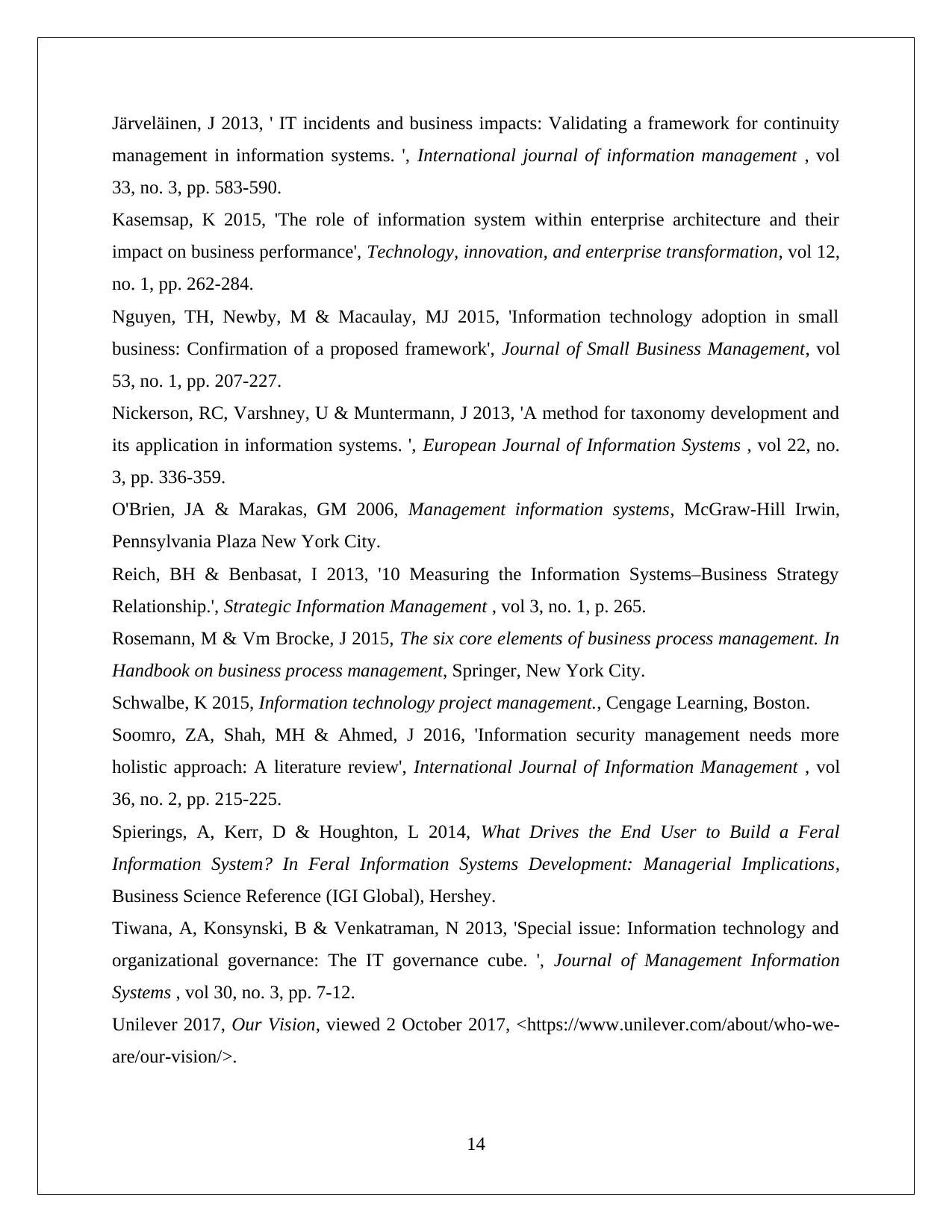
Järveläinen, J 2013, ' IT incidents and business impacts: Validating a framework for continuity
management in information systems. ', International journal of information management , vol
33, no. 3, pp. 583-590.
Kasemsap, K 2015, 'The role of information system within enterprise architecture and their
impact on business performance', Technology, innovation, and enterprise transformation, vol 12,
no. 1, pp. 262-284.
Nguyen, TH, Newby, M & Macaulay, MJ 2015, 'Information technology adoption in small
business: Confirmation of a proposed framework', Journal of Small Business Management, vol
53, no. 1, pp. 207-227.
Nickerson, RC, Varshney, U & Muntermann, J 2013, 'A method for taxonomy development and
its application in information systems. ', European Journal of Information Systems , vol 22, no.
3, pp. 336-359.
O'Brien, JA & Marakas, GM 2006, Management information systems, McGraw-Hill Irwin,
Pennsylvania Plaza New York City.
Reich, BH & Benbasat, I 2013, '10 Measuring the Information Systems–Business Strategy
Relationship.', Strategic Information Management , vol 3, no. 1, p. 265.
Rosemann, M & Vm Brocke, J 2015, The six core elements of business process management. In
Handbook on business process management, Springer, New York City.
Schwalbe, K 2015, Information technology project management., Cengage Learning, Boston.
Soomro, ZA, Shah, MH & Ahmed, J 2016, 'Information security management needs more
holistic approach: A literature review', International Journal of Information Management , vol
36, no. 2, pp. 215-225.
Spierings, A, Kerr, D & Houghton, L 2014, What Drives the End User to Build a Feral
Information System? In Feral Information Systems Development: Managerial Implications,
Business Science Reference (IGI Global), Hershey.
Tiwana, A, Konsynski, B & Venkatraman, N 2013, 'Special issue: Information technology and
organizational governance: The IT governance cube. ', Journal of Management Information
Systems , vol 30, no. 3, pp. 7-12.
Unilever 2017, Our Vision, viewed 2 October 2017, <https://www.unilever.com/about/who-we-
are/our-vision/>.
14
management in information systems. ', International journal of information management , vol
33, no. 3, pp. 583-590.
Kasemsap, K 2015, 'The role of information system within enterprise architecture and their
impact on business performance', Technology, innovation, and enterprise transformation, vol 12,
no. 1, pp. 262-284.
Nguyen, TH, Newby, M & Macaulay, MJ 2015, 'Information technology adoption in small
business: Confirmation of a proposed framework', Journal of Small Business Management, vol
53, no. 1, pp. 207-227.
Nickerson, RC, Varshney, U & Muntermann, J 2013, 'A method for taxonomy development and
its application in information systems. ', European Journal of Information Systems , vol 22, no.
3, pp. 336-359.
O'Brien, JA & Marakas, GM 2006, Management information systems, McGraw-Hill Irwin,
Pennsylvania Plaza New York City.
Reich, BH & Benbasat, I 2013, '10 Measuring the Information Systems–Business Strategy
Relationship.', Strategic Information Management , vol 3, no. 1, p. 265.
Rosemann, M & Vm Brocke, J 2015, The six core elements of business process management. In
Handbook on business process management, Springer, New York City.
Schwalbe, K 2015, Information technology project management., Cengage Learning, Boston.
Soomro, ZA, Shah, MH & Ahmed, J 2016, 'Information security management needs more
holistic approach: A literature review', International Journal of Information Management , vol
36, no. 2, pp. 215-225.
Spierings, A, Kerr, D & Houghton, L 2014, What Drives the End User to Build a Feral
Information System? In Feral Information Systems Development: Managerial Implications,
Business Science Reference (IGI Global), Hershey.
Tiwana, A, Konsynski, B & Venkatraman, N 2013, 'Special issue: Information technology and
organizational governance: The IT governance cube. ', Journal of Management Information
Systems , vol 30, no. 3, pp. 7-12.
Unilever 2017, Our Vision, viewed 2 October 2017, <https://www.unilever.com/about/who-we-
are/our-vision/>.
14
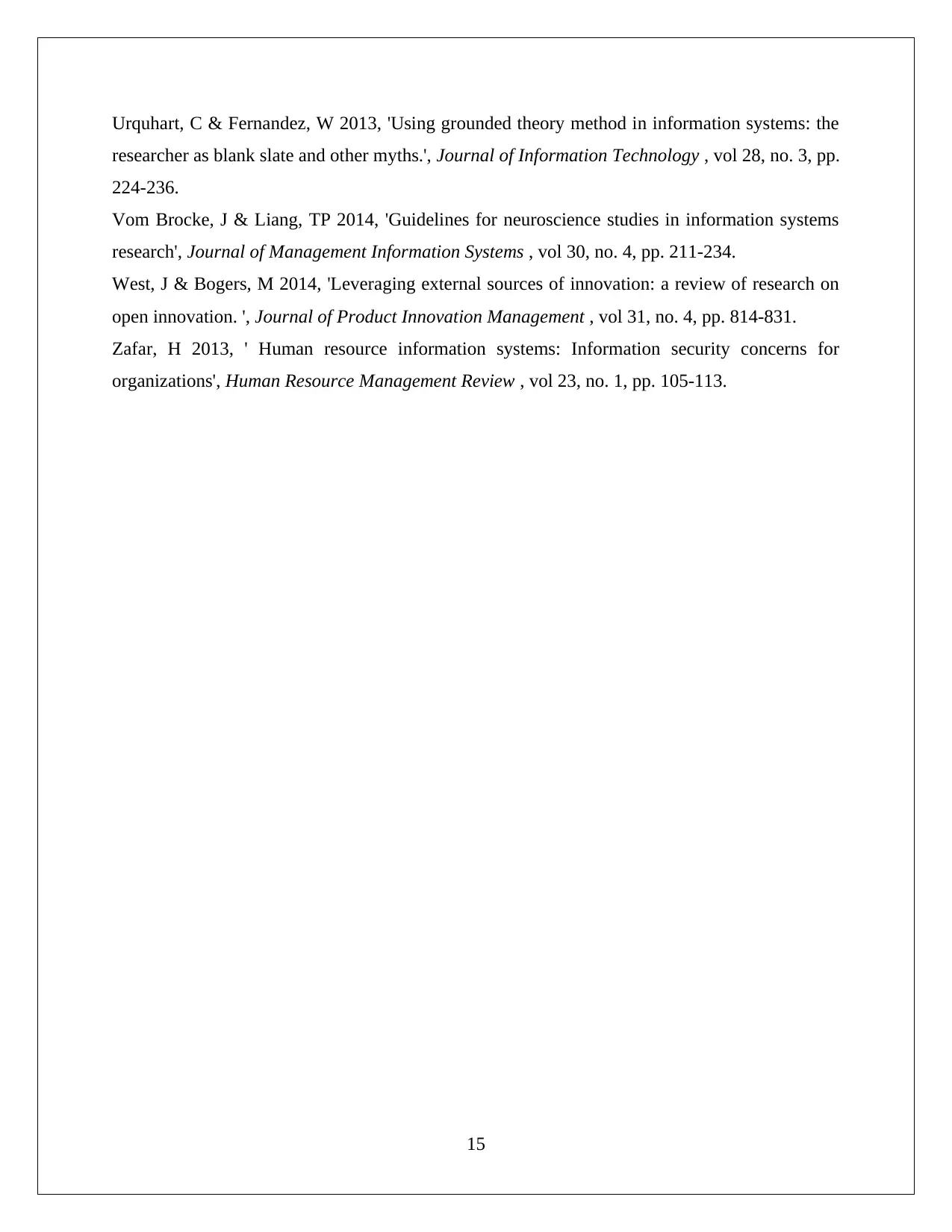
Urquhart, C & Fernandez, W 2013, 'Using grounded theory method in information systems: the
researcher as blank slate and other myths.', Journal of Information Technology , vol 28, no. 3, pp.
224-236.
Vom Brocke, J & Liang, TP 2014, 'Guidelines for neuroscience studies in information systems
research', Journal of Management Information Systems , vol 30, no. 4, pp. 211-234.
West, J & Bogers, M 2014, 'Leveraging external sources of innovation: a review of research on
open innovation. ', Journal of Product Innovation Management , vol 31, no. 4, pp. 814-831.
Zafar, H 2013, ' Human resource information systems: Information security concerns for
organizations', Human Resource Management Review , vol 23, no. 1, pp. 105-113.
15
researcher as blank slate and other myths.', Journal of Information Technology , vol 28, no. 3, pp.
224-236.
Vom Brocke, J & Liang, TP 2014, 'Guidelines for neuroscience studies in information systems
research', Journal of Management Information Systems , vol 30, no. 4, pp. 211-234.
West, J & Bogers, M 2014, 'Leveraging external sources of innovation: a review of research on
open innovation. ', Journal of Product Innovation Management , vol 31, no. 4, pp. 814-831.
Zafar, H 2013, ' Human resource information systems: Information security concerns for
organizations', Human Resource Management Review , vol 23, no. 1, pp. 105-113.
15
1 out of 15
Related Documents
Your All-in-One AI-Powered Toolkit for Academic Success.
+13062052269
info@desklib.com
Available 24*7 on WhatsApp / Email
![[object Object]](/_next/static/media/star-bottom.7253800d.svg)
Unlock your academic potential
© 2024 | Zucol Services PVT LTD | All rights reserved.





